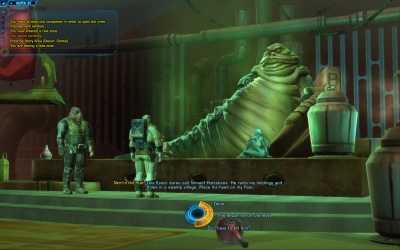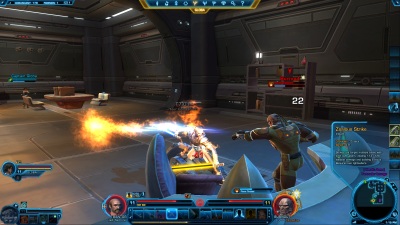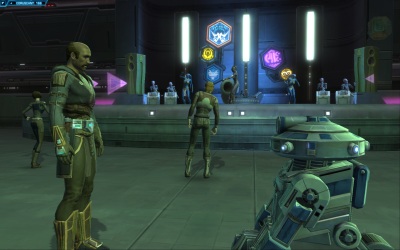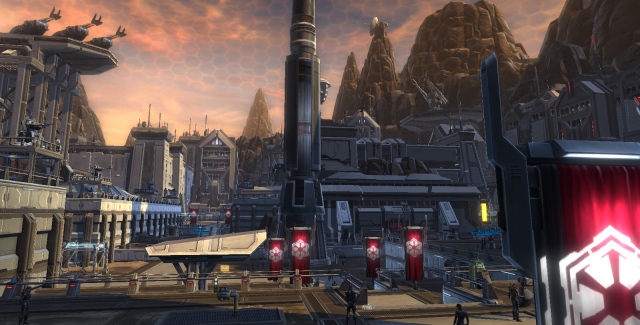Bioware are gifted storytellers
It shows that BioWare has a long track record of creating excellent stories and dialogue in role-playing games, from Baldur’s Gate to Mass Effect. Almost every quest in The Old Republic is presented with a fully-voiced interactive conversation, much in the tradition of Bioware’s single-player RPGs. Hearing spoken lines and seeing the drama unfold from multiple camera angles isn’t exactly groundbreaking per se, but a big step forward for storytelling in MMORPGs.
The writing and voice acting are spot-on and create a special mood for each character class. The Old Republic’s dialogue scenes don’t offer the same high level of visual detail as single-player games like Mass Effect 2, but are good enough to make direct competitors like World of Warcraft look outdated in that department.
Sith with a heart of gold (relatively speaking)
All the eye and ear candy aside, the dialogue system also lets players pick from three different replies during conversations. Usually they just add flavor by selecting a cocky response or more polite lines. Sometimes these choices actually influence the outcome of a quest, granting the character light or dark points, which can be collected to gain access to special gear and titles.
 This basically allows me to play odd characters like a Sith with a heart of gold or a rather mean-spirited Jedi, adding a nice splash of role-playing freedom. But the goodness or evilness of moral choices is relative to my character’s faction. As an example, in an early Imperial mission I have to sabotage the water reservoirs of slaves in order to stop their uprising. The dark points solution is to dose the poison in such a way that the victims die a slow, painful death, to set an example. Light points are earned by releasing enough poison to kill the slaves quickly. Kindness is relative among the Sith.
This basically allows me to play odd characters like a Sith with a heart of gold or a rather mean-spirited Jedi, adding a nice splash of role-playing freedom. But the goodness or evilness of moral choices is relative to my character’s faction. As an example, in an early Imperial mission I have to sabotage the water reservoirs of slaves in order to stop their uprising. The dark points solution is to dose the poison in such a way that the victims die a slow, painful death, to set an example. Light points are earned by releasing enough poison to kill the slaves quickly. Kindness is relative among the Sith.
Each class has a unique story arc that stretches all the way to the maximum character level 50, giving players a real incentive to try different avatars. The atmosphere and mood are quite different depending on what hero I’m playing. For each chosen character class, new players begin their galactic adventures on one of four planets. Sith have more fun – I like the content, look and feel of the Empire’s kickoff settings a tad better than the Republic’s initial stomping grounds.
For example, Inquisitors start out on the ancient Sith home world Korriban to begin their trials at the local academy, where the curriculum is filled with intrigues, treachery and murder. Our character is a former slave who was granted access to the academy because the Force seems to be mighty strong within her. But this is no Hogwarts; failing students are usually punished by death. After some twist and turns, our character overcomes these perils, learns more about her origins and starts serving Sith Lord Zash in her quest to assemble powerful relics on various planets.
Fight the new boss, same as the old boss
The quality of the storytelling and the interactive conversations do a decent job of masking the fact that missions usually revolve around, well, killing things. The Old Republic is not above the proven rinse and repeat gameplay formula of typical MMORPGs. Killing enemies and collecting quest rewards leads to character level promotions, resulting in access to better gear and more powerful abilities, which are needed to fight ever stronger foes on the next planet.
 The combat looks action-packed, but is essentially the same old ability management gameplay typical for MMORPGs. Most special attacks require a certain resource, like Focus energy, and can only be activated again after a certain cooldown time period. Fighting enemies is all about picking targets and the right skill for each combat situation.
The combat looks action-packed, but is essentially the same old ability management gameplay typical for MMORPGs. Most special attacks require a certain resource, like Focus energy, and can only be activated again after a certain cooldown time period. Fighting enemies is all about picking targets and the right skill for each combat situation.
The Old Republic often pits single players against whole enemy groups, giving even minor skirmishes a heroic feel. The scope of battles and cool visual effects, like whirring lightsabers or exploding grenades, make fighting fun and satisfying. But players who have always hated the combat style of World of Warcraft won’t find anything drastically different here; an action game this is not.
Human and alien resources – get to know your companions
The Old Republic adds a big twist to combat in the form of companion characters. So-called “pet classes” are nothing new. In World of Warcraft, hunters can tame wild animals, while warlocks summon demons to assist them in combat. The Old Republic doesn’t limit companions to certain classes, but allows every character to unlock five sidekicks over the course of the game. These party members have specific abilities and can be outfitted with better equipment.
 Companions also add plenty of story flavor as they mumble the occasional comment while exploring and sometimes even want to have a deep, meaningful discussion. They have their own moral codex; player choices in dialogues can increase or decrease their relationship rating. Once this hits a certain level (careful gift-giving doesn’t hurt), even romance options might become available. Improving the relationship score can also unlock companion missions and new background story revelations.
Companions also add plenty of story flavor as they mumble the occasional comment while exploring and sometimes even want to have a deep, meaningful discussion. They have their own moral codex; player choices in dialogues can increase or decrease their relationship rating. Once this hits a certain level (careful gift-giving doesn’t hurt), even romance options might become available. Improving the relationship score can also unlock companion missions and new background story revelations.
A game character can only have one companion tagging along by his side, but I can choose between up to five crew members to compliment my play style. If I want my enemies to be distracted so that I can cast Force spells undisturbed, bringing a robust “tank” helper with taunt abilities is highly beneficial. If I don’t mind being the center of my enemies’ attention, a different companion who will heal me during the battle might be a better option.

